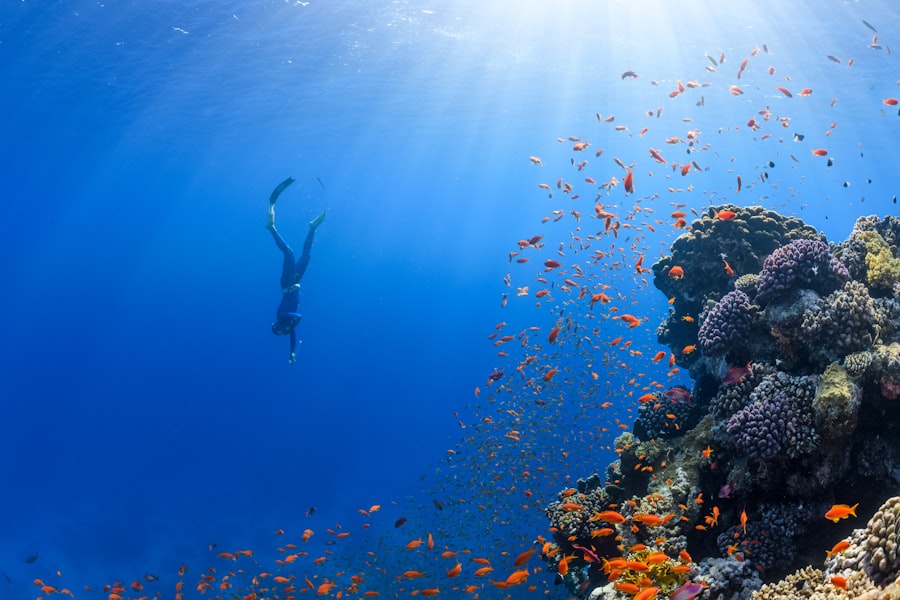Download links
How to install Exploring the Shallow Seas: 8k8 Diving Adventure APK?
1. Tap the downloaded Exploring the Shallow Seas: 8k8 Diving Adventure APK file.
2. Touch install.
3. Follow the steps on the screen.
Description
Shallow sea diving offers a unique and enchanting experience that captivates both novice and seasoned divers alike. The allure of these underwater realms lies not only in their vibrant ecosystems but also in the accessibility they provide. Unlike deeper dives, which often require extensive training and specialized equipment, shallow sea diving can be enjoyed by individuals with varying levels of experience.
The crystal-clear waters, teeming with life, create a mesmerizing environment where divers can immerse themselves in the beauty of marine biodiversity without the complexities associated with deeper dives. The shallow seas are often characterized by their stunning coral reefs, seagrass beds, and rocky outcrops. These habitats serve as nurseries for countless marine species, providing shelter and sustenance.
As divers glide through these underwater gardens, they are greeted by a kaleidoscope of colors—vibrant corals in shades of pink, purple, and orange, schools of fish darting in and out of crevices, and the gentle sway of seaweed dancing with the currents. The tranquility of shallow waters allows for a more intimate connection with nature, as divers can observe the intricate behaviors of marine life up close. This immersive experience fosters a deep appreciation for the delicate balance of these ecosystems and the importance of their preservation.
Key Takeaways
- Shallow sea diving offers a unique opportunity to explore vibrant marine life and stunning underwater landscapes.
- Exploring shallow sea ecosystems provides an exhilarating experience and a chance to encounter a diverse range of marine species.
- Safety tips for shallow sea diving include proper training, equipment checks, and staying within safe depth limits.
- Essential equipment for shallow sea diving includes a wetsuit, mask, snorkel, fins, and a buoyancy control device.
- Some of the best shallow sea diving locations include the Great Barrier Reef, the Red Sea, and the Maldives, offering unparalleled beauty and biodiversity.
- Conservation efforts for shallow sea ecosystems are crucial to preserving these delicate environments, including reducing pollution, protecting marine habitats, and promoting sustainable diving practices.
The Thrill of Exploring Shallow Sea Ecosystems
Exploring shallow sea ecosystems is akin to stepping into a living gallery where every corner reveals a new masterpiece of nature. The thrill of discovery is palpable as divers encounter a diverse array of species, from the smallest nudibranchs to larger inhabitants like sea turtles and rays. Each dive presents an opportunity to witness the dynamic interactions within these ecosystems, such as predation, symbiosis, and competition for resources.
The vibrant life forms that inhabit these waters are not only visually stunning but also play crucial roles in maintaining ecological balance. One of the most exhilarating aspects of shallow sea diving is the chance to observe behaviors that are often hidden from view in deeper waters. For instance, divers may witness clownfish darting in and out of anemones, or parrotfish grazing on coral.
These interactions provide insight into the complex relationships that define marine life. Additionally, shallow waters often serve as feeding grounds for larger predators, such as sharks and barracudas, which can add an element of excitement to the dive. The thrill of encountering these majestic creatures in their natural habitat is an unforgettable experience that underscores the importance of conservation efforts aimed at protecting these fragile ecosystems.
Safety Tips for Shallow Sea Diving

While shallow sea diving is generally considered safer than deeper dives, it is essential for divers to adhere to safety protocols to ensure a safe and enjoyable experience.
This practice not only enhances safety but also enriches the diving experience through shared observations and discoveries.
Divers should establish clear communication signals before entering the water and maintain close proximity throughout the dive. In case of an emergency, having a buddy nearby can be invaluable. Another critical aspect of safety is being aware of environmental conditions.
Divers should check weather forecasts and tide schedules before heading out, as changes in currents or visibility can significantly impact the dive experience. It is also advisable to familiarize oneself with local marine life, including potential hazards such as jellyfish or sea urchins. Understanding the behavior of these creatures can help divers avoid unwanted encounters.
Additionally, divers should always carry safety equipment such as a whistle or surface marker buoy to signal for help if needed. By prioritizing safety measures, divers can fully enjoy the wonders of shallow sea diving while minimizing risks.
Equipment Needed for Shallow Sea Diving
| Equipment | Description |
|---|---|
| Mask and Snorkel | Allows the diver to see underwater and breathe at the surface |
| Fins | Helps the diver to move efficiently through the water |
| Wetsuit | Provides thermal insulation and protection from marine life |
| Weight Belt | Helps the diver to achieve neutral buoyancy |
| Dive Computer | Monitors depth, time, and decompression limits |
| Regulator | Delivers air from the tank to the diver’s mouth |
| Buoyancy Control Device (BCD) | Allows the diver to control buoyancy and stay at a desired depth |
| Tank | Contains compressed air for breathing underwater |
The equipment required for shallow sea diving is relatively straightforward compared to deeper dives, making it accessible for beginners. A well-fitting mask and snorkel are essential for clear vision and easy breathing while exploring the underwater world. Fins are also crucial, as they provide propulsion and allow divers to navigate efficiently through the water.
For those who prefer to dive rather than snorkel, a wetsuit may be necessary to maintain body temperature, especially in cooler waters. In addition to basic gear, divers may benefit from using a dive computer or depth gauge to monitor their time underwater and depth levels. While shallow dives typically do not require complex decompression planning, keeping track of these factors can enhance safety and enjoyment.
A buoyancy control device (BCD) is also recommended for divers who wish to maintain neutral buoyancy while exploring coral reefs or seagrass beds. Finally, underwater cameras or GoPros can capture the breathtaking beauty encountered during dives, allowing divers to share their experiences with others and promote awareness about marine conservation.
Best Shallow Sea Diving Locations
There are numerous breathtaking locations around the world that are ideal for shallow sea diving, each offering unique ecosystems and experiences. One such destination is the Great Barrier Reef in Australia, renowned for its stunning coral formations and diverse marine life. The shallow areas of this UNESCO World Heritage site provide opportunities to encounter colorful fish species, sea turtles, and even dolphins in their natural habitat.
The vibrant coral gardens are easily accessible from various points along the coast, making it a popular choice for divers of all skill levels. Another exceptional location is the Caribbean Sea, particularly around islands like Bonaire and Cozumel. These regions boast crystal-clear waters and thriving coral reefs that are home to an abundance of marine species.
Bonaire’s marine park is famous for its commitment to conservation and offers numerous shore diving opportunities where divers can explore vibrant reefs just steps from the beach. Cozumel’s Palancar Reef is another must-visit site, known for its dramatic drop-offs and rich biodiversity. The warm waters and excellent visibility make these locations perfect for both novice and experienced divers seeking unforgettable underwater adventures.
Conservation Efforts for Shallow Sea Ecosystems

The preservation of shallow sea ecosystems is critical not only for marine biodiversity but also for human communities that rely on these resources for their livelihoods. Various conservation efforts are underway globally to protect these fragile environments from threats such as pollution, overfishing, and climate change. Marine protected areas (MPAs) have been established in many regions to safeguard critical habitats and promote sustainable practices among local communities.
These designated zones restrict certain activities that could harm marine life, allowing ecosystems to recover and thrive. In addition to MPAs, organizations dedicated to marine conservation work tirelessly to raise awareness about the importance of preserving shallow sea ecosystems. Initiatives such as beach clean-ups, educational programs, and citizen science projects engage local communities in conservation efforts while fostering a sense of stewardship for their natural surroundings.
By involving individuals in hands-on activities that directly impact their environment, these programs cultivate a deeper understanding of marine ecosystems and inspire action toward their protection. Furthermore, research plays a vital role in conservation efforts by providing valuable data on the health of shallow sea ecosystems. Scientists study various factors affecting these environments, including water quality, species diversity, and habitat degradation.
This information informs policy decisions and helps guide conservation strategies aimed at mitigating threats to marine life. Collaborative efforts between governments, non-profit organizations, and local communities are essential in creating effective conservation frameworks that ensure the long-term sustainability of shallow sea ecosystems for future generations. In conclusion, shallow sea diving presents an extraordinary opportunity to explore vibrant underwater worlds filled with diverse marine life while emphasizing the importance of safety and conservation efforts.
As divers immerse themselves in these breathtaking environments, they not only experience the thrill of discovery but also become advocates for protecting these fragile ecosystems that are vital to our planet’s health.
If you’re interested in exploring more about the world of underwater adventures, you may want to check out this article on Instagram 3. This related piece discusses the use of social media platforms to share stunning photos and videos from shallow sea diving experiences. It provides insights into how divers can capture and showcase their underwater explorations to a wider audience.
FAQs
What is 8k8 Shallow sea diving?
8k8 Shallow sea diving is a type of diving that takes place in shallow waters, typically at depths of 8 to 8 meters (26 to 26 feet). It is a popular form of diving for beginners and those looking to explore the marine life and underwater environment in a safe and controlled manner.
What equipment is used for 8k8 Shallow sea diving?
The equipment used for 8k8 Shallow sea diving is similar to that used for regular scuba diving, including a mask, snorkel, fins, buoyancy control device (BCD), regulator, and a tank of compressed air. Divers may also use a wetsuit or drysuit depending on the water temperature.
Is 8k8 Shallow sea diving safe?
When conducted with proper training, supervision, and equipment, 8k8 Shallow sea diving can be a safe and enjoyable activity. It is important for divers to adhere to safety guidelines and receive proper instruction from certified diving professionals.
What are the benefits of 8k8 Shallow sea diving?
8k8 Shallow sea diving allows individuals to explore the underwater world and observe marine life in a relatively shallow and controlled environment. It can also serve as a stepping stone for those interested in pursuing deeper and more advanced forms of diving.
Are there any risks associated with 8k8 Shallow sea diving?
As with any form of diving, there are inherent risks associated with 8k8 Shallow sea diving, including decompression sickness, barotrauma, and equipment malfunctions. It is important for divers to be aware of these risks and take necessary precautions to mitigate them.
What training is required for 8k8 Shallow sea diving?
Individuals interested in 8k8 Shallow sea diving are encouraged to undergo training and certification through a recognized diving organization, such as PADI or NAUI. This training typically includes classroom instruction, pool sessions, and open water dives to ensure divers are competent and confident in their abilities.





